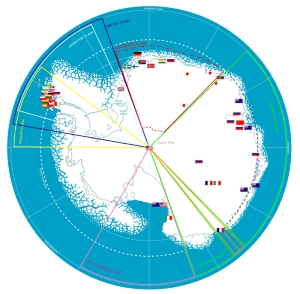Did you know that seven countries have claims in Antarctica?At the end of World War II, seven countries claimed sovereignty in Antarctica. Some of these claims were partly overlapping and there was a risk of international conflict that involved the superpowers.

At the time of the second Norvegia expedition in 1929, Norway laid claim to the tiny island of Peter I Øy (180 square kilometres) off the coast of west Antarctica. In 1939 Norway claimed a much greater expanse of territory, namely Dronning Maud Land, an area seven times as large as all of Norway. The motivation for these Norwegian claims was the possibility of ensuring the right to hunt whales in the Southern Ocean. Before Norway presented its claim, Great Britain had already laid claim to most of Antarctica, parcelling out the sectors between itself, New Zealand and Australia, and France had also claimed a large sector. Chile and Argentina put in their own claims in 1940 and 1942, respectively. The Argentinian, British, and Chilean claims overlap, which has led to some inconsistencies. Australia has the largest claim sector in Antarctica. Australia, France, New Zealand, Norway, and Great Britain have recognised each other’s claims. However, several countries did not recognise them, and some countries (USA and the former Soviet Union) maintained that they had a right to sectors in Antarctica, without ever actually making any such claims. During the International Geophysical Year 1957-1958, twelve countries – including the seven with territorial claims – joined together in an ambitious scientific collaboration, and as a result, the international Scientific Committee on Antarctic Research (SCAR) was established. This collaboration paved the way for the discussions that eventually led to the Antarctic Treaty, which was finalised in 1959. The Antarctic Treaty put all claims of sovereignty “on ice”. The existence of these claims is acknowledged, but no decision will be made about them as long as the current treaty runs. The Antarctic Treaty stipulates that the continent shall not be used for military activities, nuclear testing or storage of nuclear waste, and that all parties have the right to inspect each others’ activities. This prevents conflicts, and has enabled Antarctica to develop into a place reserved for peace and research. |
South Pole 1911–2011 is an informational outreach project run by the Norwegian Polar Institute
Contact person:


